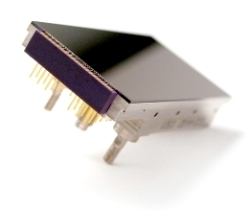May 18 2010
On 17th May 2010, e2v Charge Coupled Device (CCD) imaging sensors are due to be launched into space on board the Japan Aerospace Exploration Agency’s (JAXA) Venus Climate Orbiter “Akatsuki” (formally known as PLANET-C) to study the planet Venus. e2v CCD47-20 sensors equip the spacecraft’s Ultraviolet Imager (UVI).
 CCD Imaging Sensors
CCD Imaging Sensors
Akatsuki will use infrared light to make a detailed investigation of Venus, often referred to as Earth’s sister planet because of their similar size, gravity and mass; but their climates are very different. Venus has the densest atmosphere of all the terrestrial planets, which consists mainly of carbon dioxide, with an extremely high temperature and thick sulfuric-acid clouds. Studies have suggested that several billion years ago, Venus had an atmosphere that was much more similar to Earth’s. It is thought to have possessed Earth-like oceans that evaporated as the temperature rose, causing a greenhouse effect that left the planet with dry deserts and a critical level of greenhouse gases in its atmosphere. Akatsuki’s investigation into the causes for this environment will provide understanding of the birth of Earth and its own climate changes and explain how such a diversity of planetary environments has evolved in the solar system.
The spacecraft’s state of the art instruments will explore the deep atmosphere and the ground surface below the thick cloud layer. It will enter an elliptical orbit, 300 to 80,000 km from Venus’s surface. The variation in distance will allow Akatsuki to make comprehensive observations of the planet’s meteorological phenomena, its surface and also the atmospheric particles escaping from Venus into space. Close up images will be taken and the storm winds that blow on its surface (at speeds that reach 100m a second) will be observed.
e2v CCD47-20 sensors equip the Ultraviolet Imager (UVI) onboard Akatsuki. It is a frame transfer CCD, with 1024 x 1024 pixels, each 13µm square. The device is back-illuminated, with optimised processing and coatings for performance in the 280nm – 365nm wavelength range. It is housed in a hermetically sealed package, with a sapphire window also optimised for transmission in the UV range.
UVI is designed to measure ultraviolet radiation scattered from cloud tops at ~65 km altitude in two bands centred at 283 nm and 365 nm wavelengths. The Venusian atmosphere shows broad absorption of solar radiation between 200 and 500 nm; SO2 at the cloud top explains the absorption in the range between 200 nm and 320 nm, while the absorption above 320 nm should be due to another absorber that is not yet identified. Identification of the absorber is important not only for atmospheric chemistry but also for the energy balance and dynamics of the atmosphere, because the species influence the albedo and the heating profile of the atmosphere. UVI will make clear the spatial distributions of these ultraviolet absorbers and their relationships with the cloud structure and the wind field. The tracking of cloud motions yields the wind vectors at the cloud top. The vertical distributions of cloud particles and the haze layer above the main cloud will be studied with limb observations. With a field of view of 12 degrees, the full disk of Venus can be captured in one image at distances >8.5 Rv.
Jon Kemp, Marketing & Applications Manager for e2v’s Imaging division said “Our CCD47-20 has a long and growing space heritage in a variety of applications. e2v is proud to have supplied these image sensors to JAXA for another important mission, and wish them every success in gaining a better understanding of the environment on Venus. We very much look forward to working with them again in the future.”